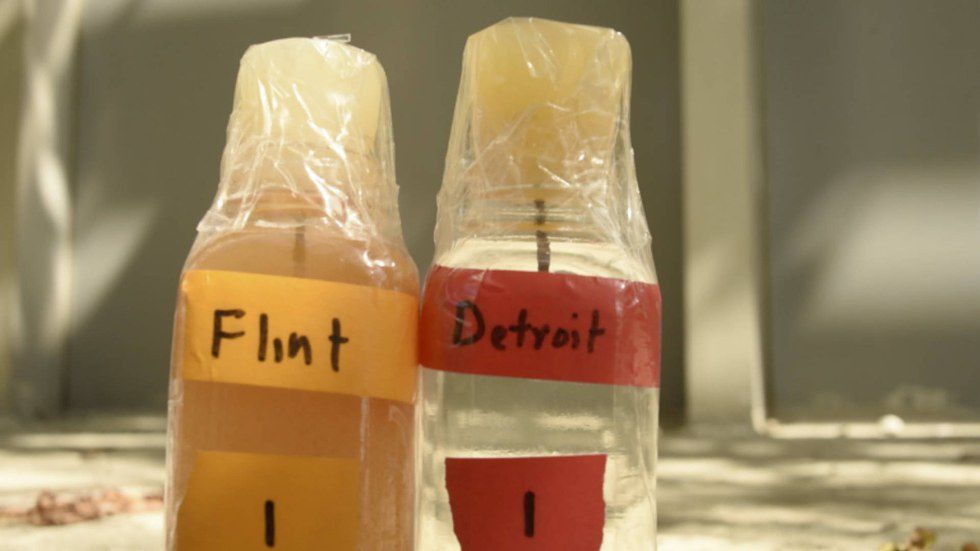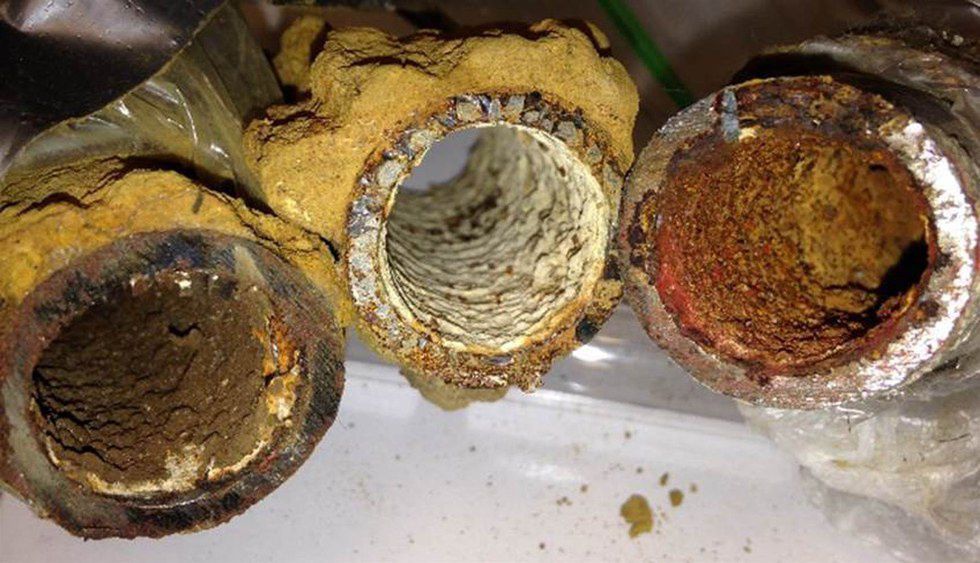Flint: a word that once evoked the image of a rock used to create fire and gunpowder and is now the city that's on everyone's "What the heck, how did this happen, and how is it still continuing?" list. Since the beginning of last year, Flint, Michigan, has been on everyone's radar, stirring up controversy in the news about the water crisis and how and why it even started. Many say it was simple bureaucratic incompetence; others say it was a cog in our country's institutionalized racism.
Either way, the federal government has taken serious notice and three city workers were charged with felonies on April 20. Two city workers, Stephen Busch and Michael Prysby, at the Michigan Department of Environmental Quality were charged with "misconduct in office, tampering with evidence, and violation of the safe drinking act." The third man was Mike Glasgow who was a supervisor of Flint's water treatment, was charged with two separate felonies: tampering evidence and willful neglect as a public officer. The allegations are that Glasgow "altered and falsified reports sent to the Department of Environmental Quality (DEQ) and the Environmental Protection Agency (EPA)."
These arrests may not be enough to satisfy the city of Flint. Thousands are calling for the arrest and prosecution of Governor Rick Snyder. Where did all this controversy and pollution come from? How did the land of the free and home of the brave end up poisoning thousands of its citizens?
How Flint Became National News
In Flint, 41.6 percent of its residents are below the poverty line. 56.6 percent of its residents are African American. Once the home pf General Motors and known as the "Vehicle City," this area now will be known for sites of one of the worst failures in local and state government history.
In 2013, the city of Flint decided that Detroit's city water was no longer for them. They needed the good, natural stuff: Lake Huron. So they signed an agreement in March 2013 to stop buying Detroit's city water and enter into the Karegnondi Water Authority (KWA) to pump water into the city through a new pipeline from Lake Huron. This deal would supposedly save the city $19 million.
Until the pipeline was completed, the city would continue to depend on Detroit's water. However, after signing the KWA agreement, Detroit backed out and Flint was forced to find a temporary water source: the tributary, renown for its "filth." While some thought of this switch as "a joke," the city officials agreed regardless to the switch while they waited out the KWA's pipeline completion. The switch to the tributary water was to save the city $5 million. Flint was all about saving money; what city isn't?
On April 25, 2014, the city officially switched the Detroit water off and switched to the river water. The mayor of Flint claimed it was a "historic moment... to return to its roots and use its own river as our drinking water supply."
Flint's Water Controversies
Mere weeks (probably even days) after the switch, citizens realized their water looked akin to cider but tasted akin to dirt. Flint's residents started buying bottled water to show their disgust with the water. The mayor continued to stand up for the water's quality, saying, "It's a quality, safe product" and that citizens were "wasting their money" by buying bottles of water.
In August, the city issued "boil water" advisories after fecal coliform bacteria was discovered. On October 13, 2014, General Motors claimed that they would no longer use the Flint water because it caused corrosion on metals. On January 2, 2015, the city mailed a notice about the dangerous levels of TTHM (trihalomethanes) in the water. These were a "group of four chemicals that are formed as a byproduct of disinfecting water." For those with "compromising immune systems" such as the elderly, sick, and infants or children, boiling the water or not using it entirely was suggested.
Shortly after, Detroit offered to let Flint back on their water system without charging Flint with a reconnection fee in a proposal of goodwill toward the health and safety of Flint citizens. Flint declined their offer.
By January 20, when environmental activist Erin Brockovich weighed on the issue, saying the city had to "stop making excuses," thousands on social media started drawing a prejudiced connection between Flint's racial status and poverty lines. The mayor of Flint admitted that they all "underestimated" the damage the river water would do and how much treatment would be needed for the water.
Detroit again tried to come to Flint's rescue, but the city's pride got in the way when officials claimed they had no authority. The governor gave the city $2 million to fix the water problem on February 3, 2015. Meetings and arrangements were made with slow-moving decisions underway.
A new $1.6 million carbon filter system was to be implemented in July 2015 in an effort to treat the Flint water source. This wouldn't do as much as they wanted for the water's safety, however. So the council voted 7-1 to reconnect with the Detroit water and the city's emergency manager, Jerry Ambrose was appalled at how the city wanted to spend more money for water that was "no safer than water from Flint" -- a comment that was obviously a lie (direct your gaze back up to the water quality comparison picture above).
A lawsuit was filed in June, asking the judge to order Flint to reconnect with Detroit water. It was dismissed. Another suit in August order the city to roll back it's water and sewage rates 35 percent in an effort to earn more money to treat the poisonous water.
Poison in the Water
Then it all hit the fan in September when Virginia Tech Professor Marc Edwards claimed that the corrosive pipes According to the report, "On a scientific basis, Flint River water leaches more lead from plumbing than does Detroit water." According to the EPA, "If more than 10 percent of samples exceed 15 parts per billion, then water systems are required to take action"; twenty percent of samples from Flint exceeded the 15 ppb limit.
Then Flint children's blood lead levels spiked, doubling their levels in a year, deadly for some children and extremely unhealthy for all. The study reported that "the percentage of Flint infants and children with above average lead levels has nearly doubled citywide, and has nearly tripled among children in "high risk" areas of lead exposure." To this the state refuted the study, saying "blood lead levels in Flint have remained fairly steady for children under 16 years old since the city switched from Lake Huron water to the river." Either way, the mayor of flint issues "lead-in-water" notices to Flint's residents as a warning.
It seems that for almost every issue of public safety and health, the state replied that the evidence was invalid or simply untrue.
Finally, on October 1, officials of the county issued a Public Healthy Emergency urging its residents to avoid drinking the water unless it had been checked for lead and/or other contaminants. This wasn't practical for most of the citizens, however, because they use water every day. Cooking, cleaning, bathing, drinking, etc. Water is a necessity that the government should not allow to be contaminated. As a Republican representative of Utah stated in House discussion on the issue, "We are not some third world country who allows poisoned water."
The next day, the governor of Michigan issued a plan to solve the water crisis that involved spending $1 million on filters. Five days later, there was a meeting discussing going back on Detroit's water plan. Since then there have been over fifty lawsuits and hundreds of cases of E.Coli, skin lesions, hair loss, miscarriages, and even Legionnaire's Disease.
Despite all the media, legal intervention, and governmental involvement, the water crisis is still ongoing and citizens are urged to use bottled water for any water needs. Glasgow is claiming that he was told by higher-ups to disregard the contamination levels and to lie on reports. He claims that he knows that he should have made changes or sought help, but he wasn't sure how. While this is a difficult matter, he still had a choice in it all.
All residents of Flint are asking for is clean water. Water that won't poison them or their families. Their children are sick, brains damaged, bodies deteriorating, and lives crumbling in on themselves -- all because a city thought it would save them some money if they switched Flint's water supply for a few years to a disgusting river. How did this happen? Why did this happen? Why is this still happening? Why isn't the water safe in spite of all these changes?
I guess we'll have to "stay tuned" for the rest of the unraveling Flint catastrophe. That is, after all, the advice government officials give Flint residents whenever someone asks about the water situation. Stay tuned. Sit tight. Buy bottled water. As if they are all wealthy and have the money to throw on bottled water.
And when you ask why no one wanted to help Flint, perhaps you should ask yourself whether the officials truly cared. If they did, it was simply bureaucracy negligence or incompetence. If they did not, then there could indeed be something much more sinister at play in our country where "all men are" -- supposedly -- "created equal."























